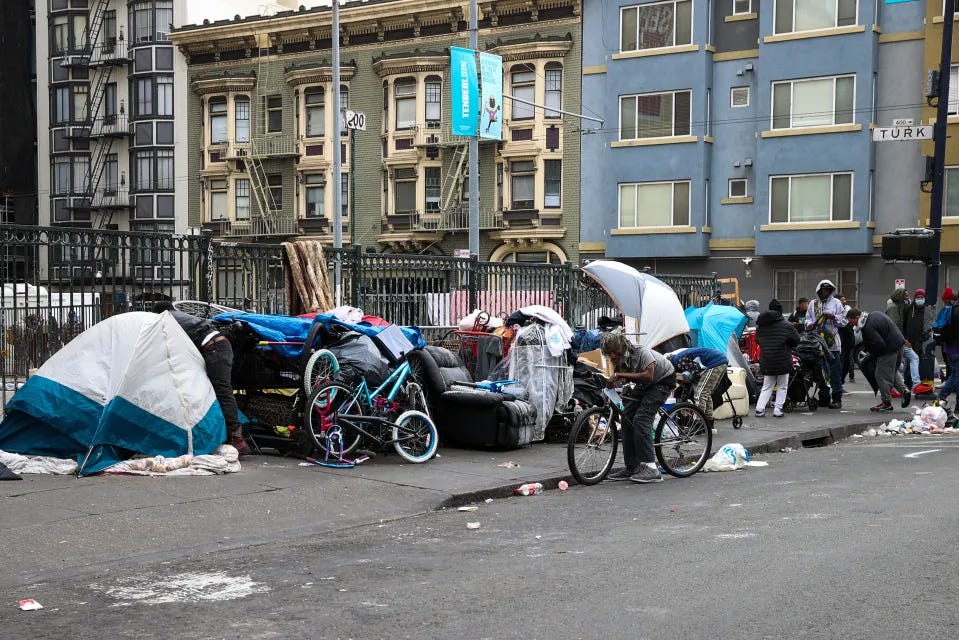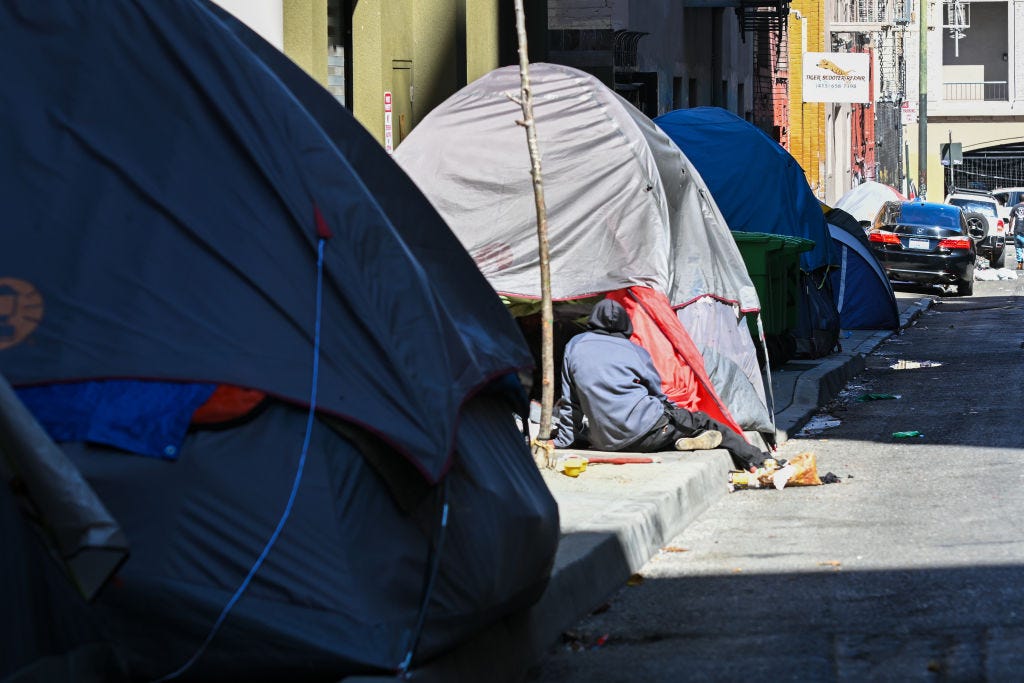Containment zones or homelessness-- Which is the better choice for San Francisco?
In lieu of a full June 10th meeting recap
This article discusses the fight over Supervisor Mahmood and Supervisor Walton’s new ordinance to prevent the overconcentration of homeless shelters in East SF.
Trade-offs:
While natural trade-offs in politics were always a difficult sell, I think the internet has made the problem much worse. To say nothing of the fact that the ease of modern amenities trains humans to forget the realities of sacrifice, modern media is incompatible with an objective assessment of pros and cons. Sensationalism, simplicity, and seething anger are the name of the game.
Some politicians get around this hitch by ignoring the concept of trade-offs altogether. Take SF leftists, for example. “We want universal social housing that doesn’t upset the community or change its character or cast shadows, so we’ll oppose any development that doesn’t meet these standards.” The trade-offs between perfection and not building housing simply don’t exist in this reality. And San Francisco has paid the price, because as it turns out, they do.
While some issues are more clear-cut than others, progressive politicians must start to consistently weigh the tradeoffs of every policy they pursue, even and especially in lose-lose situations. In that vein, the most recent fight bubbling up between the SF board and the Mayor presents a particularly difficult Sophie’s Choice. Which is worse for the city: more homelessness or containment zones?
Attempting to do both—The battle over Supervisor Walton and Mahmood’s new ordinance:
In April, Supervisor Walton and Mahmood introduced a seemingly daring piece of legislation. Their “Geographic Equity” plan would force every single district in the city to approve a new homeless shelter (or similar facility) by June 2026. It would also ban the creation of new shelters within 1,000 feet of an existing facility without a specific hearing and approval by the board. As it stands, almost every single shelter in the city lies within a handful of concentrated areas in East SF.
However, although the ordinance inspired broad support—including endorsements from Supervisors Dorsey, Fielder, Sauter, and Melgar—it encountered trouble behind the scenes from the Mayor’s office. Part of the issue is that Mayor Lurie possesses key bases of support in the suburban districts that Mahmood/Walton’s legislation aimed at. But he also correctly identified a defect in this ordinance. While it makes it genuinely difficult to build new shelters near existing ones, it doesn’t actually offer a means of forcing resistant districts to approve new shelters. If they don’t make the June 2026 deadline, then all they have to fear is being indirectly scolded at a bi-annual board progress hearing (very scary!) In short, this well-intentioned legislation could result in fewer shelters at a time when we desperately need to help people off the streets.
So Lurie moved to defang the ordinance. Chief among his reported proposed amendments was that A. Districts must only “endeavor” to approve a new shelter, and B. The 1,000-foot ban on shelters was replaced with a provision that only banned new shelters once there are enough beds for every homeless resident—essentially, eliminating any enforcement mechanism.
“Will you continue to disregard community voice?”
Supervisor Walton responded by confronting the Mayor indirectly at the June 10th general board meeting. In a tense line of questioning reminiscent of exchanges between Mayor Breed and the board, Walton hammered Lurie on his decision to support the addition of almost 100 beds to the Jerrold senior resident homeless shelter in Bayview. He demanded to know of Lurie: “Will you pause the proposal to add beds to the site on Jerrold? Or will you continue to disregard community voice and pretend like you want to work together in good faith, when in reality, you make unilateral decisions and stress low-income communities, communities of color, and communities that don't have big pockets?”
Lurie responded that “Interim housing capacity is one of the most urgent and humane steps we can take as a city to meet the needs on our streets,” and that the Jerrold site is a key part of that. He also added that his staff was meeting weekly with community representatives as part of a “robust” outreach process.
Unconvinced, Walton pushed back:
“You did not answer my question...no one supports it… You continue to claim that you work with supervisors, that you work collaboratively, but you unilaterally put this shelter in Bayview. You're unilaterally trying to put an amendment on the budget that will increase the footprint not only at Jerrold but also at the Bayview Navigation Center. And in some of our conversations, you claim that you would like to address homelessness in the areas where we see people who are unhoused—yet there's not a proposed shelter by the beach, there's not a proposed shelter by Golden Gate Park, there's not a proposed shelter by Lake Merced.”
Nowhere in Walton’s comments did he acknowledge the impact on homeless residents if the Jerrorld expansion were to halt. Mayor Lurie, to his credit, didn’t push back and instead agreed to disagree, arguing he was doing what was best for San Francisco. Walton’s line of questioning likely presages a fraying relationship between Lurie and leftist board members.
West SF cannot be allowed to ignore its failings:
I wrote in the past (and still believe) that this legislation has a pretty damn good point, and I’m sympathetic with Walton’s frustration. As the ordinance’s press release stated, Districts 1, 7, 8, and 11 have a grand total of 0 emergency shelters. Instead, historic zoning practices belied by explicitly racist sentiments have pushed the vast majority of homeless shelters into the city’s less affluent eastern areas—particularly throughout long stretches of Mahmood and Walton’s districts. This map by Mission Local is especially saddening. It wasn't until a couple of years ago that shelters were even permitted in most of the city.
As anyone who has walked around the Tenderloin knows, the overconcentration of homeless shelters and SROs often takes a toll. Whether you call it a containment zone or a slum or blighted or whatever the correct terminology is now, it’s bad. While not every Eastern neighborhood is at this level, it’s a disproportionate burden regardless.
Moreover, the eastern areas of San Francisco–some areas like North Beach notwithstanding–have for decades also shouldered the responsibility of building most new homes. In the last twenty years, for instance, SOMA and Mission Bay have grown by over 150% while the West–busy trying to pretend it’s a Palo Alto suburb–has been almost completely static. I remember one of my first introductions to SF housing politics being the “No Slums in the Sunset” campaign to kill an affordable project on 26th and Irving. These types of residents carry more blame for San Francisco’s homelessness crisis than anyone else. It is absurd to argue that they should not share in shouldering negative externalities from new shelters.
And while it’s true that homeless shelters (although not affordable housing developments!) can slightly increase localized petty crime and decrease property values, that’s a good argument for spacing these shelters out across the city—not sectioning off black and urban areas as blight containment zones. Furthermore, although the east side of SF does have more resources for the homeless and addicts, A. There are still thousands of homeless citizens who need support in the West, and B. That’s just an argument for building those resources throughout the city.
But does that make the “Spatial Equity” ordinance the right move?
The state of the TL is abhorrent, and it would be a sin to kick it down further. But blocking a shelter bed in East SF is not going to magically make one appear elsewhere. This is a matter of trade-offs, and if this bill passes as is, it could mean more human beings continuing to live on the streets. In a city that has twice as many homeless people as beds, that’s a horrible thought. And I’m not sure if I believe it’s worth it.
Maybe this bill will embarrass the West and inspire genuine change in our spatial equity. But that’s a big ask. Lurie’s decision to remove language mandating new shelters in every decision–language that doesn’t even include an enforcement mechanism–is a cynical ploy not to anger conservative West SF NIMBYs. But his fears over the 1,000 feet rule are very valid.
Ultimately, what this legislation needs to work is a way of guaranteeing that every district builds more shelters. For example, maybe the legislation could offer height bonuses for shelters in non-compliant districts, take a peek at the planning code, or set aside more money for shelters in these areas. Maybe it could punish districts with upzoning when they fail to build enough shelters. I’m sure the legality gets hazy, but maybe there’s even a way to directly or indirectly slash the discretionary funds going to West SF. After all, there’s a hell of a lot of shelters and homes in the TL and a hell of a lot of roads in the underpopulated West. Just how proportionate is our infrastructure spending? Maybe this bill could offer something more than a Sophie’s Choice.
But absent that?
As much as Supervisor Walton may lament the lack of community support for new shelter beds in his district, that’s a story we’ve heard all too often in the past. We’re in the trouble we’re in now in San Francisco and California because of a habitual reliance on blocking new developments. Luxury projects, affordable projects, homeless shelters, mansions, mobile homes; in areas rich and poor; we’ve blocked them all. So while there are times when new developments are wrong, it’s crucial that a well-meaning board doesn’t lose sight of the tradeoffs at play.
Unintended consequences are costly.






I live in one of the "containment zones". There should be at least an equal investment in these communities as what gets put into supportive housing and services. There should be public bathrooms, more trash cans, dedicated cleaning teams (not CBD which we pay for ourselves), small business subsidies, etc
If the street conditions weren't terrible, having more support for drug addicts and unhoused wouldn't receive as much pushback.
Consider that Soma has the least amount of green space of all the districts while also having added the most amount of housing. There's more to spatial equity than just homeless shelters.
How about we just not build new things that have "negative externalities" until we've fixed the negative externalities that already exist?